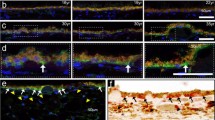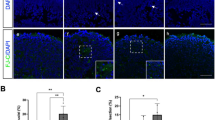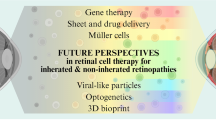Abstract
Neurotrophin-3 (NT-3), a neurotrophic factor that mainly binds to the tyrosine kinase C (trkC) receptor, has been shown to play a crucial role in proliferation, differentiation, and survival. However, the role of NT-3 in the hypoxia-induced retinopathy has not been investigated extensively. Here, we created a model of hypoxia (1% O2) in vitro and found that hypoxia promoted the apoptosis of mouse cone photoreceptor-derived 661W cells, increased the expression of TrkC and cleaved caspase-3. In contrast, the hypoxia-mediated 661W cell apoptosis was markedly alleviated by co-culturing with primary mouse Müller cells. Further mechanism studies revealed that hypoxia increased the synthesis and secretion of NT-3 by Müller cells, and exogenous NT-3 stimulation increased the phosphorylation of extracellular signal-regulated kinase (ERK) 1/2 by binding to TrkC in 661W cells. Besides, both siRNA knockdown of TrkC expression and incubation with an ERK-specific inhibitor PD98059 triggered apoptosis in hypoxic 661W cells. Altogether, these data suggest that NT-3 originating from Müller cells protects photoreceptors from hypoxia-induced apoptosis through a TrkC/ERK-dependent pathway. Our findings may facilitate future studies on the therapeutic implications of NT-3 in the treatment of hypoxia-relevant retinal diseases.






Similar content being viewed by others
References
Arden GB, Sivaprasad S (2011) Hypoxia and oxidative stress in the causation of diabetic retinopathy. Curr Diabetes Rev 7:291–304
Barben M, Ail D, Storti F, Klee K, Schori C, Samardzija M, Michalakis S, Biel M, Meneau I, Blaser F, Barthelmes D, Grimm C (2018) Hif1a inactivation rescues photoreceptor degeneration induced by a chronic hypoxia-like stress. Cell Death Differ 25:2071–2085
Blasiak J, Petrovski G, Vereb Z, Facsko A, Kaarniranta K (2014) Oxidative stress, hypoxia, and autophagy in the neovascular processes of age-related macular degeneration. Biomed Res Int 2014:768026
Boss JD, Singh PK, Pandya HK, Tosi J, Kim C, Tewari A, Juzych MS, Abrams GW, Kumar A (2017) Assessment of neurotrophins and inflammatory mediators in vitreous of patients with diabetic retinopathy. Investig Ophthalmol Vis Sci 58:5594–5603
Bringmann A, Pannicke T, Grosche J, Francke M, Wiedemann P, Skatchkov SN, Osborne NN, Reichenbach A (2006) Muller cells in the healthy and diseased retina. Prog Retin Eye Res 25:397–424
Das I, Sparrow JR, Lin MI, Shih E, Mikawa T, Hempstead BL (2000) Trk C signaling is required for retinal progenitor cell proliferation. J Neurosci 20:2887–2895
Dawbarn D, Allen SJ (2003) Neurotrophins and neurodegeneration. Neuropathol Appl Neurobiol 29:211–230
Grimm C, Willmann G (2012) Hypoxia in the eye: a two-sided coin. High Alt Med Biol 13:169–175
Han KA, Woo D, Kim S, Choii G, Jeon S, Won SY, Kim HM, Heo WD, Um JW, Ko J (2016) Neurotrophin-3 regulates synapse development by modulating TrkC-PTPsigma synaptic adhesion and intracellular signaling pathways. J Neurosci 36:4816–4831
Harada T, Harada C, Nakayama N, Okuyama S, Yoshida K, Kohsaka S, Matsuda H, Wada K (2000) Modification of glial–neuronal cell interactions prevents photoreceptor apoptosis during light-induced retinal degeneration. Neuron 26:533–541
Hicks D, Courtois Y (1990) The growth and behaviour of rat retinal Muller cells in vitro. 1. An improved method for isolation and culture. Exp Eye Res 51:119–129
Ivanov SV, Panaccione A, Brown B, Guo Y, Moskaluk CA, Wick MJ, Brown JL, Ivanova AV, Issaeva N, El-Naggar AK, Yarbrough WG (2013) TrkC signaling is activated in adenoid cystic carcinoma and requires NT-3 to stimulate invasive behavior. Oncogene 32:3698–3710
Kurihara T, Westenskow PD, Gantner ML, Usui Y, Schultz A, Bravo S, Aguilar E, Wittgrove C, Friedlander M, Paris LP, Chew E, Siuzdak G, Friedlander M (2016) Hypoxia-induced metabolic stress in retinal pigment epithelial cells is sufficient to induce photoreceptor degeneration. Elife 5:e14319
Li SY, Fu ZJ, Lo AC (2012) Hypoxia-induced oxidative stress in ischemic retinopathy. Oxid Med Cell Longev 2012:426769
Li R, Wu Y, Jiang D (2016) NT-3 attenuates the growth of human neuron cells through the ERK pathway. Cytotechnology 68:659–664
Mervin K, Valter K, Maslim J, Lewis G, Fisher S, Stone J (1999) Limiting photoreceptor death and deconstruction during experimental retinal detachment: the value of oxygen supplementation. Am J Ophthalmol 128:155–164
Nag TC, Wadhwa S (1999) Neurotrophin receptors (Trk A, Trk B, and Trk C) in the developing and adult human retina. Brain Res Dev Brain Res 117:179–189
Oku H, Ikeda T, Honma Y, Sotozono C, Nishida K, Nakamura Y, Kida T, Kinoshita S (2002) Gene expression of neurotrophins and their high-affinity Trk receptors in cultured human Muller cells. Ophthalmic Res 34:38–42
Pardue MT, Allen RS (2018) Neuroprotective strategies for retinal disease. Prog Retin Eye Res 65:50–76
Shen W, Zhu L, Lee SR, Chung SH, Gillies MC (2013) Involvement of NT3 and P75(NTR) in photoreceptor degeneration following selective Muller cell ablation. J Neuroinflamm 10:137
Steinberg RH (1987) Monitoring communications between photoreceptors and pigment epithelial cells: effects of "mild" systemic hypoxia. Friedenwald lecture. Investig Ophthalmol Vis Sci 28:1888–1904
Taylor S, Srinivasan B, Wordinger RJ, Roque RS (2003) Glutamate stimulates neurotrophin expression in cultured Muller cells. Brain Res Mol Brain Res 111:189–197
Wangsa-Wirawan ND, Linsenmeier RA (2003) Retinal oxygen: fundamental and clinical aspects. Arch Ophthalmol 121:547–557
Wellard J, Lee D, Valter K, Stone J (2005) Photoreceptors in the rat retina are specifically vulnerable to both hypoxia and hyperoxia. Vis Neurosci 22:501–507
Acknowledgements
This study was supported by Grants from National Natural Science Foundation of China (Nos. 81670861, 81800826).
Author information
Authors and Affiliations
Corresponding author
Ethics declarations
Conflict of interest
The authors have no conflict of interest to report.
Additional information
Publisher’s Note
Springer Nature remains neutral with regard to jurisdictional claims in published maps and institutional affiliations.
Rights and permissions
About this article
Cite this article
Li, N., Zhu, Y., Wang, J. et al. Müller cells derived neurotrophin-3 inhibits hypoxia-induced photoreceptor apoptosis via the TrkC/ERK pathway. Cytotechnology 72, 47–56 (2020). https://doi.org/10.1007/s10616-019-00356-9
Received:
Accepted:
Published:
Issue Date:
DOI: https://doi.org/10.1007/s10616-019-00356-9




